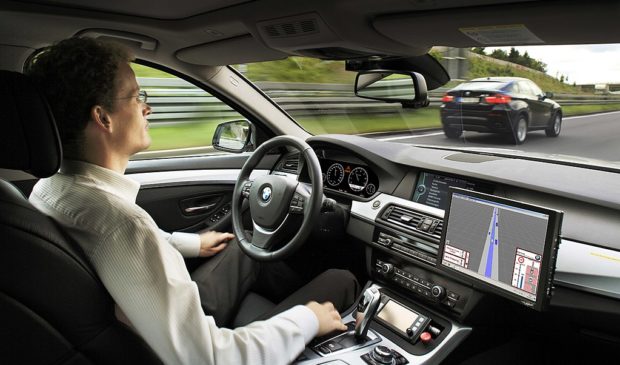City debuts robot car roadmap
Monday, October 16, 2017 by
Caleb Pritchard The dawn of the robot car future is just around the corner but the full obsolescence of human drivers is still decades away, according to Austin Transportation Director Robert Spillar.
More specifically, Spillar told the Mobility Transformation Advisory Council earlier this month that a complete conversion to automated vehicles will likely be 40 years down the line.
In the meantime, he said, the city and region will need to continue to invest in transit, sidewalks and other multimodal transportation options.
“If we continue to conceive of automated technologies just as a replacement for the driver-owned vehicle, I’m not sure we can achieve some of the municipal goals that we’re still after,” Spillar said.
Spillar’s briefing marked the formal debut of the city’s Smart Mobility Roadmap, a document commissioned by City Council to prepare for a possible future in which the current paradigm of individually owned, gas-powered cars is replaced by a new regime of shared, automated and electric vehicles.
“These technologies are going to be mixed with cars that are still human-driven so we need to start focusing on that more than the idyllic future,” he explained.
The Mobility Transformation Advisory Council is a cross-jurisdictional body that counts among its members representatives from City Council, city staff, Travis County, the Capital Metropolitan Transportation Authority, the Capital Area Metropolitan Planning Organization, the Central Texas Regional Mobility Authority, Austin’s state legislative delegation, the Rocky Mountain Institute and the Austin Chamber of Commerce.
Spillar told the body that the Smart Mobility Roadmap is just that, rather than a plan.
“How do we bring people to opportunities more cheaply, more efficiently and more effectively,” he posited rhetorically. “This is just one more tool to do that.”
Spillar’s chief of staff, Karla Taylor, the chief author of the roadmap, illustrated just how far away the city is from the reality of streets dominated by electric cars, let alone self-driving ones. She pointed out that there are currently only approximately 4,000 electric-powered vehicles in the Austin area.
“That represents about four-tenths of 1 percent of the million vehicles in our city today. So if we’re to achieve 25 percent in electric vehicles, that’s a large, steep hill to climb. So we have to think about the policies that we are going to try in order to encourage greater and faster adoption,” said Taylor.
She said that government vehicle fleets will likely convert to electric power before consumers do, but that prevailing research suggests that advancing technology will bring the cost of battery-powered cars in line with their gas-guzzling progenitors by 2025.
According to Taylor, a full 3 percent of Austin’s workforce would find themselves out of a job in a world of robot cars where delivery drivers to bus operators are no longer necessary. Spillar suggested however that the human element could still be a part of professional transportation services.
“Suddenly vehicles could be attended by docents in a sense or customer service agents and multiple vehicles could drive together to reach distant locations very efficiently, so this is a real game-changer for shared mobility in terms of transit,” he said.
Taylor also pointed out that the technology offers a “silver lining” for Austin’s technology sector.
“There’s a potentially $560 billion market in automated vehicle sales by 2035. Largely that’s going to be based on software. Austin is a leader in software and technology development and we think that’s a sweet spot for Austin to take advantage of,” she said.
This story has been changed since publication to clarify the fact that the cost of battery-powered cars is predicted to be in line with their counterpoints by 2025. Photo by BP63Vincent (Own work) [CC BY-SA 3.0], via Wikimedia Commons.
The Austin Monitor’s work is made possible by donations from the community. Though our reporting covers donors from time to time, we are careful to keep business and editorial efforts separate while maintaining transparency. A complete list of donors is available here, and our code of ethics is explained here.
You're a community leader
And we’re honored you look to us for serious, in-depth news. You know a strong community needs local and dedicated watchdog reporting. We’re here for you and that won’t change. Now will you take the powerful next step and support our nonprofit news organization?



